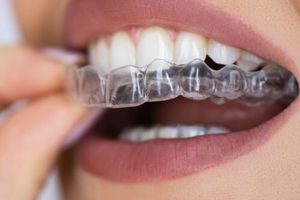A straight, confident smile is a goal for many, but the cost of orthodontic treatment can be a deciding factor. If you’re considering Invisalign treatment, you may be wondering: how much does Invisalign cost? While Invisalign aligners are a popular alternative to traditional braces, the price can vary depending on multiple factors, including your treatment plan, dental clinic, and private health insurance coverage.
In this article, we’ll break down the Invisalign cost, how it compares to metal braces, what influences the total cost, and whether Invisalign is worth the investment for your teeth straightening treatment.
What is Invisalign, and Why is It So Popular?
Invisalign is an advanced orthodontic solution that straightens teeth using a series of clear aligners. Unlike traditional metal braces that rely on stainless steel wires and brackets, Invisalign aligners are crafted from smooth, medical-grade plastic, making them nearly invisible when worn.
Why is Invisalign So Popular?
- Aesthetically Pleasing: Invisalign aligners are transparent, offering a subtle solution for individuals looking to straighten their teeth without the visibility of traditional braces.
- Comfortable Fit: Unlike metal braces, Invisalign trays do not have sharp edges or wires, reducing irritation to the cheeks and gums.
- Removable: You can take Invisalign out while eating, drinking, brushing, and flossing, making it easier to maintain oral hygiene.
- Fewer Dental Visits: Since multiple sets of aligners are provided in advance, patients do not need as many adjustments as with traditional braces.
- Customised Treatment Plan: Invisalign aligners are tailored to each individual’s orthodontic treatment, providing a more personalised treatment experience.
- Suitable for Various Orthodontic Issues: Invisalign is effective for managing mild to moderate cases of misaligned teeth, spacing issues, crowding, and bite irregularities.
This combination of convenience, comfort, and aesthetics makes Invisalign one of the most sought-after teeth straightening treatments today.
But how much does Invisalign treatment cost, and is it the right treatment option for you?
How Much Does Invisalign Cost in Australia?
The starting cost of Invisalign treatment in Australia typically begins at $3,500 AUD. However, the total price varies depending on factors such as the degree of complexity of your orthodontic treatment, the duration of your treatment plan, and the fees set by your dental clinic.
Several factors influence the cost of Invisalign, including:
- Severity of Orthodontic Issues: More complex cases require longer treatment and additional necessary adjustments.
- Dental Clinic and Location: Prices may vary depending on the experience of Australian licensed dentists and the clinic’s location.
- Health Insurance Coverage: Some private health insurance policies cover part of the Invisalign cost under dental coverage.
- Additional Treatments: Some patients may require further treatments or future orthodontic work, impacting the overall cost.
Since costs vary depending on individual needs, it’s best to book an initial consultation with a dental practice to receive a personalised quote for your teeth straightening treatment.
How Does Invisalign Compare to Traditional Braces?
When choosing between Invisalign treatment and traditional braces, there are several factors to consider, including appearance, comfort, treatment duration, and cost. Here’s a detailed comparison of the two teeth straightening treatments to help you decide which treatment option suits your needs best.
1. Appearance: Invisalign is More Discreet
Invisalign Aligners: Made from clear plastic, Invisalign trays are virtually invisible, making them a favourable choice for adults and professionals who prefer a discreet teeth straightening treatment.
Traditional Braces: Made from stainless steel brackets and wires, traditional dental braces are highly visible. Some people opt for white or clear ceramic brackets to make them less noticeable, but they are still more visible than Invisalign.
2. Comfort: Smooth Aligners vs. Metal Brackets
Invisalign Aligners: Designed with smooth edges, Invisalign aligners are designed for a comfortable fit, reducing the risk of irritation or discomfort to the gums and inner cheeks. Each aligner is custom-made to fit securely over your teeth, applying gentle pressure to gradually move them into the desired position.
Traditional Braces: Metal brackets and wires often cause irritation inside the mouth, especially in the early stages. Patients may experience soreness after adjustments. Lingual braces, positioned on the inner side of the teeth, can cause discomfort as they come into contact with the tongue.
3. Removability: Invisalign Offers More Flexibility
Invisalign Aligners: One of Invisalign’s biggest advantages is that the aligners are removable. You can take them out when eating, drinking, and brushing; this allows for easier maintenance of proper oral hygiene.
Traditional Braces: Fixed in place for the entire treatment duration, metal braces cannot be removed. This means food can get trapped around metal brackets, requiring extra care and special cleaning tools to maintain oral health.
4. Treatment Duration: Similar Timeframes, Case Dependent
Invisalign Aligners: The length of treatment varies depending on the severity of the case. Mild cases may take 6–12 months, while moderate to complex cases can take 18–24 months.
Traditional Braces: Similarly, the treatment duration with metal braces depends on the complexity of the misalignment. Severe cases may require 24 months or more, whereas mild cases can take around 12–18 months.
5. Eating and Drinking: Invisalign Has Fewer Restrictions
Invisalign Aligners: Since the aligners are removable, there are no dietary restrictions. You can eat whatever you like, as long as you remove your aligners beforehand and brush your teeth before putting them back in.
Traditional Braces: Foods such as hard candies, popcorn, and sticky sweets should be avoided, as they can damage metal brackets or become lodged in the wires.
6. Cleaning and Maintenance: Invisalign is Easier to Maintain
Invisalign Aligners: Cleaning Invisalign trays is simple – they only need to be rinsed and brushed regularly.
Traditional Braces: Braces require special cleaning tools, such as floss threaders and interdental brushes, to remove food particles and plaque buildup. Keeping metal brackets clean can be more challenging than keeping them with Invisalign.
7. Dental Visits: Fewer Check-Ups with Invisalign
Invisalign Aligners: Requires fewer visits to the dental clinic, as multiple aligner trays are provided in advance. Patients usually visit their dental practice every 6–8 weeks for progress checks.
Traditional Braces: Requires frequent adjustments, usually every 4–6 weeks, as metal brackets and wires need tightening to continue shifting the teeth.
8. Cost: Invisalign is More Expensive Than Metal Braces
Invisalign Aligners: Invisalign in Australia starts at $3,500 AUD, but the total cost varies based on the complexity of the treatment plan.
Traditional Braces: Metal braces have a starting cost of $3,000 AUD, making them generally a cheaper alternative to Invisalign for those with more severe misalignment issues.
9. Suitability: Invisalign is Ideal for Mild to Moderate Cases
Invisalign Aligners: Best suited for mild to moderate orthodontic issues, such as crooked teeth, gaps, or minor bite problems. Severe cases may require additional orthodontic work in the future.
Traditional Braces: More effective for complex cases involving significant misalignment, overcrowding, or severe bite correction. Metal brackets provide greater control over the movement of teeth.
10. Effectiveness: Traditional Braces Provide More Precision
Invisalign Aligners: Works well for mild to moderate cases, but may not be suitable for all complex orthodontic cases. Aligners must be worn consistently (20–22 hours per day) to achieve the desired results.
Traditional Braces: Can address a wider range of orthodontic issues, including severe crowding, significant bite misalignment, and rotation of teeth. Metal brackets provide stronger force and more precision in moving teeth.
Which is the Better Option?
Choose traditional braces if you need to correct severe misalignment or bite issues. While they are more noticeable and require extra care, they provide greater control over complex orthodontic treatment needs.
If you’re unsure about the best dental treatment option, consult an Australian licensed dentist to assess your orthodontic issues and discuss whether Invisalign or traditional braces will help you achieve a beautiful, straight smile.
Payment Options for Invisalign: Making Treatment More Affordable
Investing in Invisalign treatment is a step toward achieving a beautiful, straight smile, but the cost can be a concern for many. Fortunately, several payment options can help make Invisalign more affordable, allowing patients to manage their expenses through flexible financial solutions.
1. Early Access to Superannuation for Orthodontic Treatment
Under certain circumstances, patients may be able to access their superannuation early to help cover the cost of Invisalign. This option is beneficial for people who require orthodontic treatment for medical or functional reasons rather than purely cosmetic purposes. If you are eligible, you can apply through the relevant government scheme to use your superannuation funds for your teeth straightening treatment. Consulting with a qualified financial advisor or your dental clinic can help determine if you meet the criteria for early withdrawal.
2. National Dental Plan (NDP) – Interest-Free Payment Plans
The National Dental Plan (NDP) allows eligible patients to spread the cost of Invisalign over time through an interest-free payment plan. This option enables you to start treatment immediately while making manageable fortnightly or monthly payments. NDP offers:
- No interest on repayments
- Flexible repayment terms
- Instant approval for eligible applicants
This plan is ideal for those who do not want to pay the full amount upfront and prefer a structured way to cover their treatment costs.
3. Total Lifestyle Credit (TLC) – Flexible Financing Solutions
Total Lifestyle Credit (TLC) provides flexible financing options to help cover Invisalign treatment costs. With TLC, patients can access funding for major dental procedures, including orthodontic care, with repayment plans tailored to their financial situation. Benefits of TLC include:
- Competitive interest rates
- Fast approvals
- Customised repayment terms to suit different budgets
This financing solution is an excellent choice for those looking for an alternative to traditional payment plans while ensuring that their aligner treatment is affordable.
Choosing the Best Payment Option for Your Invisalign Treatment
Each patient’s financial situation is unique, and selecting the right payment plan depends on individual preferences and eligibility. Before committing to an option, it’s advisable to discuss your needs with your dental practice and explore the available dental coverage options through private health insurance.
By leveraging these payment plans and financing solutions, Invisalign can become more accessible, allowing you to achieve a confident, straight smile without financial stress.
Your Invisalign Journey: A Step-by-Step Guide to a Straighter Smile
Choosing Invisalign treatment is an exciting step toward achieving a straighter, more confident smile. But what exactly happens from your first consultation to the day you complete your treatment? Let’s walk through the process so you know what to expect every step of the way.
Step 1: The Initial Consultation – Is Invisalign Right for You?
Your journey begins with a visit to an Australian licensed dentist who is experienced in clear aligners. During this initial consultation, your dentist will:
- Assess your orthodontic issues, such as crooked teeth, bite misalignment, or gaps.
- Take digital scans, X-rays, or impressions to understand your teeth positioning.
- Discuss your treatment options, estimated treatment duration, and expected results.
Step 2: Custom Treatment Plan & Digital Preview
Once your scans or impressions are taken, your aligner treatment is carefully mapped out using advanced 3D imaging technology. This allows you to:
- See a digital preview of how your teeth will move over time.
- Understand how long your teeth straightening treatment will take.
- Get an estimate of the total cost, which varies depending on the complexity of your case.
This step ensures your treatment is precisely planned to give you the best possible results.
Step 3: Getting Your First Set of Aligners
Once your Invisalign trays are ready, you’ll return to your dental clinic to pick up your first set. Your dentist will:
- Ensure they fit properly and feel comfortable.
- Explain how to wear and care for your aligner trays.
- Provide instructions on how often to switch to a new set (typically every 1-2 weeks).
At this point, your Invisalign treatment officially begins!
Step 4: Wearing Your Aligners – Consistency is Key
To achieve the best results, you’ll need to:
- Wear your clear aligners for 20–22 hours per day, only removing them for eating and oral care.
- Clean them daily to keep good oral health.
- Stay committed to your treatment plan by switching to new aligners as scheduled.
Mild discomfort is normal when changing to a new set as the aligners gradually move your teeth into place.
Step 5: Regular Check-Ups with Your Dentist
Throughout your teeth straightening journey, you’ll visit your dental practice every 6–8 weeks to:
- Monitor your progress.
- Receive new sets of aligner trays.
- Make any necessary adjustments to your treatment plan.
Unlike traditional braces, these visits are usually quick since there are no metal brackets or stainless steel wires to adjust.
Step 6: Completing Your Treatment & Retainers
Once you’ve completed your final set of Invisalign aligners, your dentist will assess your results and determine if any further treatments are needed. To keep your straight teeth in place, you’ll need to wear a retainer, which helps prevent them from shifting back.
Retainers are typically worn:
- Full-time for the first few months.
- Then only at night to maintain your beautiful straight smile long-term.
Frequently Asked Questions
- How do I know if Invisalign is right for me?
Invisalign is best for individuals with mild to moderate orthodontic issues, like crooked teeth, gaps, or bite misalignment. A consultation with an Australian licensed dentist can confirm your eligibility.
- How does Invisalign work to straighten teeth?
Invisalign consists of a series of transparent aligners that exert controlled pressure, gradually moving your teeth into their ideal position according to a personalised treatment plan.
- Can Invisalign fix severe bite issues?
While Invisalign can correct many orthodontic issues, severe bite problems or misalignment may require traditional braces or lingual braces for better control.
- Will I need retainers after Invisalign treatment?
Yes. Retainers help maintain your straight teeth by preventing them from shifting back. Your dentist will recommend the required time for you to wear them.
- How often do I need to visit my dentist during Invisalign treatment?
Most patients visit their dental clinic every 6–8 weeks to check progress and receive new aligner trays.
- Can teenagers use Invisalign instead of traditional braces?
Yes. Invisalign offers a teen-specific treatment plan designed to accommodate growing teeth, making it an effective alternative to metal braces for many teenagers.
- What if I forget to wear my aligners for a day?
If you forget to wear your Invisalign aligners for an extended period, your teeth may shift back slightly, potentially extending your treatment duration. Always wear them for 20–22 hours per day.
- Are there any dietary restrictions with Invisalign?
No. Since Invisalign trays are removable, you can eat whatever you like. However, avoid consuming sugary or staining beverages while wearing them.
- Can Invisalign close gaps between teeth?
Yes. Invisalign aligners can effectively close minor to moderate gaps between teeth, though larger gaps may require longer treatment or additional orthodontic work.
- Can I play sports while wearing Invisalign?
Yes, but if you’re playing a contact sport, consider removing the aligners and using a mouthguard for protection.
- Will I need to wear Invisalign at night?
Yes. Aligners must be worn consistently for at least 20–22 hours per day, including while sleeping, for effective results.
- Will Invisalign change how I speak?
You may experience a slight lisp initially, but this usually disappears within a few days as you adjust to wearing the aligner trays.
- Can Invisalign fix overcrowded teeth?
Yes. Invisalign can correct mild to moderate crowding, but severe cases may require further treatments, such as tooth extraction, before starting aligner treatment.
- How long does it take to see results with Invisalign?
Some patients notice changes within a few weeks, but full results typically take 6 to 24 months, depending on the complexity of the treatment plan.
Final Thoughts
While Invisalign may be more expensive than most online aligner companies, it offers a more personalised treatment and better long-term results. If you’re considering teeth straightening, consult an Australian licensed dentist for an initial consultation to discuss your options. With the right dental practice, payment options, and commitment, you can achieve the straight teeth and confident smile you’ve always wanted.
For more information about Invisalign treatment and to see if it’s right for you, Contact Dr Jack at (02) 8806 3712 – (02) 9000 1778 today to begin your journey to a stunning smile.
References
Healthline:
Healthline. (n.d.). Does Invisalign work? Healthline. Retrieved from https://www.healthline.com/health/does-invisalign-work
Invisalign:
Align Technology. (n.d.). Retainers after Invisalign. Invisalign. Retrieved from https://www.invisalign.com/resources/retainers/retainers-after-invisalign
American Association of Orthodontists (AAO):
American Association of Orthodontists. (n.d.). 7 common bite problems. Retrieved from https://aaoinfo.org/whats-trending/7-common-bite-problems/
Cleveland Clinic:
Cleveland Clinic. (n.d.). Oral hygiene. Cleveland Clinic. Retrieved from https://my.clevelandclinic.org/health/treatments/16914-oral-hygiene
Medical News Today:
Medical News Today. (n.d.). Metal braces: Uses, costs, benefits, and more. Medical News Today. Retrieved from https://www.medicalnewstoday.com/articles/metal-braces-uses-costs-benefits-and-more-2
National Dental Plan (Australia):
National Dental Plan. (n.d.). Patient information. National Dental Plan. Retrieved from https://www.nationaldentalplan.com.au/patient/












